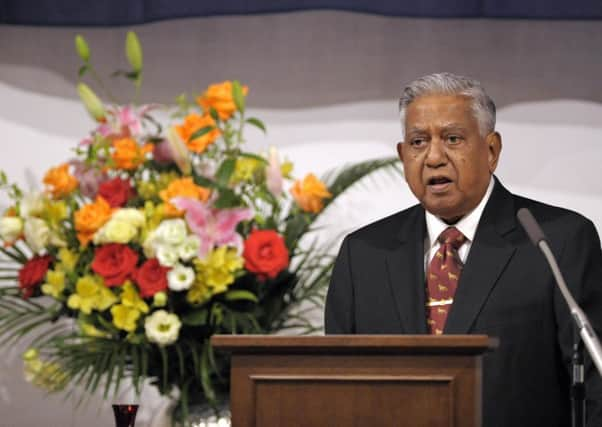Obituary: Sellapan Ramanathan (SR Nathan), statesman


The bravery and initiative of an Indian-Tamil descended Singaporean, Sellapan Ramanathan, when confronted with Japanese and Palestinian militant hijackers in January 1974, ought to make Scottish hearts proud.
Just as Singapore’s first appointed residents, the Aberdonian William Farquhar and the Islay-born John Crawfurd, sought in the 1820s to establish high morale in the new colony, so Ramanathan, known as SR Nathan, set independent Singapore an example in how to face down terror.
Advertisement
Hide AdAdvertisement
Hide AdThe attackers, armed with submachine guns, had tried to blow up oil tanks at the Shell refinery at Pulau Bukom off Singapore’s south-west coast. Frustrated, they seized a ferry, the Laju, and took the five crew hostage.
“Mr Nathan was calm, cool, and clear-headed throughout the crisis”, the police chief who worked with him recalled. Put in charge of the situation by Singapore’s then prime minister Lee Kuan Yew, Nathan – at the time Singapore’s director of security and intelligence – saved the crewmen’s lives by himself volunteering, after several days of negotiations, to lead a group of “guarantors” to take their place. The 13 guarantors flew with the militants to Kuwait. Nathan then negotiated the Singaporeans’ safe passage home.
Nathan went on to become Singapore’s ambassador to the United States from 1990-96, and at Lee Kuan Yew’s suggestion to ministers was persuaded to stand in 1999 for election as the island’s sixth president. He won, and would go on to fulfil a second term, becoming Singapore’s longest-serving head of state since independence in 1965. He welcomed the Queen to the president’s residence, the Istana –once Britain’s colonial Government House – when she visited Singapore in 2006.
Singaporeans remember him for his approachability, often speaking to people on his daily walks, and his humility.
He made no secret of the difficulties of his early life. One of seven children, the son of a legal clerk at a rubber plantation in Muar, Johore, he attended the Anglo-Chinese School and then Victoria School. His father lost his job, turned to drink and committed suicide when the boy was eight. At 16, Nathan was expelled from school. Accused of stealing textbooks and too ashamed to tell his mother, he ran away and sought work as a clerk.
He survived the Second World War Japanese occupation by working as an errand boy, and even learned Japanese. There was kindness from an officer who gave him an English-Japanese dictionary, and from another who got him a job with the Japanese civilian police as a translator.
“It was the first time anyone had told me I had a good mind,” Nathan reflected later in his memoir, An Unexpected Journey.
He went on after the war to take a diploma in social studies from the University of Malaysia, graduating in 1954, and in 1955 became a medical social worker. In 1958 he married a girl he had met while cycling on his wartime errands, Urmila Nandey, who had seen him from her window. They would have a son, Osith, and a daughter, Juthika. His wife and children survive him.
Advertisement
Hide AdAdvertisement
Hide AdBy 1962, Nathan’s talents had been noticed by Lee Kuan Yew. “Every time there was a tricky task which required a steady hand, someone dependable and who could get things done, his name would pop up”, Mr Lee later recalled of Nathan. “Many people believe that as a government, we select people by their academic credentials. Yes we do, but only in part. We place much greater weight on character.”
Nathan reached, by the early 1970s, the rank of deputy secretary in Singapore’s civil service, first in the foreign ministry, and then the ministry of home affairs.
He was no stranger to controversy in the period between his heroism in the Laju incident, and his accession to the presidency. He became, in 1982, executive chairman of the Straits Times newspaper group; and having held publishing business posts, appeared on US television as ambassador in 1994 after Singapore caned an American teenager for vandalism.
When the world financial crisis struck in 2008 during his second term as president, he impressed Singaporeans with his calm, agreeing permission, as head of state, for Singapore’s national reserves to be used to support its banks and financial companies. The following year he again allowed national reserve funds to be used to save jobs and provide credit.
During his presidency he added Mandarin to his knowledge of Tamil, English and Japanese, with the aim of being able to address Singapore’s majority Chinese population directly. After stepping down he was awarded Singapore’s highest honour, the Order of Temasek (First Class).
The island’s present prime minister, Lee Kuan Yew’s son Lee Hsien Loong, said in tribute to him: “To me, Mr Nathan’s most important role was as a tree planter. Wherever he went, he nurtured young seedlings into mature trees…. He mentored young promising officers and helped them to fulfil their potential and I count myself a beneficiary. He helped Singapore to build and to grow into a modern, prosperous and stable nation.”